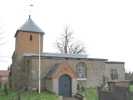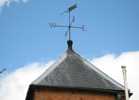 Tythby Tythby
Holy Trinity
History
Domesday does not mention a church, but a priest and a church meadow are recorded
at Tythby. The existing church dates from the 13th century and is a stone building
in the Early English style with a later brick-built bell tower. The original
window openings are Early English, probably 13th Century. Throsby points out
that there may have been an earlier chapel on the site as a piscina was uncovered
when some pews were removed. The church was dedicated, according to ancient
wills presented to the registers at York, to St Peter.
The Tythby and Cropwell Butler churches were given to Thurgarton Priory by
Matthew de Vilers in the reign of Henry II, 1154-1189. There was no resident
priest. In the taxation roll of Pope Nicholas IV, 1291, the church at
Tythby was appointed to Thurgarton Priory as £20 and was served by canons
from the Priory.
There are many mentions in the 1257 ledger book of Thurgarton Priory to the
church of Wiverton. The village of Wiverton was connected to Tythby through
its patron, and Thoroton believed that this church may be interpreted as that
of either Langar or Tythby.
There is a 14th Century, nail-studded, priest’s
door, and the font is also thought to
be originally 14th Century.
Tythby church is thought to have had a relic and Trinity Sunday was known
as
‘Relique Sunday’. There is a tablet in
the chancel to the memory of Thomas Chaworth who died on Trinity Sunday, 1435.
Relics were, however, finally swept away during the Commonwealth.
An inventory on 26th May 1553 by William Smyth and Alexandre Boube, churchwardens
shows:
one chalice is a patent of silver for the administration
of the holie communion in the same church and also ij bells of one accorde
with a saunce bell hanginge in the steeple in the church as chapel of Tithby
given to the Prior and convent of Thurgarton by the Vilers.
After the dissolution of Thurgarton Priory, the benefice was perpetual curacy
in the gift of the Musters family.
Another inventory taken in Edward VI’s reign by churchwardens John
Pinder and Richard Spenser shows :
Imprimur, one Charles, 3 altar cloths, 2 Laten candlesticks,
1 pyx of Laten, 3 towels, a vestments (3 albes, 1 black silk), 1 cope of blue
satin, 1 latyn crosse, with a baner of silk to ye same, 1 masse boke, one manuel
both delivered away according to the King’s ma’ties commandment,
1 crisimatorie of latyn, 2 corporay, 2 bells with a lesser bell called a sanctus
bell, 2 handbells, a sacryng bell and a houslyng bell. It ... a chapel with
in the same p’rche hung 2 bells, a saunctus bell, a vestment of white
silk with an albe of the same. Taken at Tithby on Vt of Sept. Ano EVI. Sexto.
The ‘Chapell with in the same p’rche’ referred to is almost
certainly one dedicated to St Nicholas in Cropwell Butler and this may
even have predated the church at Tythby. However, it is not mentioned by Thoroton
and it has been suggested that it fell into disuse after the reformation when
its goods were removed, thus leaving Tythby as the only church in the parish.
The octagonal font was repaired and dated 1662.
The bells were also dated 1662 at the Restoration.
The Protestation returns in 1676 record 5 dissenters apart from recusants.
In Archbishop Herring’s Visitation Returns in 1743, C Thomas Hebblethwaite,
curate, replied that of the 83 families, 3 women were dissenters, and called
themselves Presbyterians. There was no other meeting house or charity school.
Of 200 communicants only 27 took communion the previous Easter. “Notice
is given of the sacrament a fortnight before it is administered. The parishioners
do not send in their names, but I will admonish them to do it for the future”.
In his return to Archbishop Drummond during the 1764 Visitation, the same
curate stated that there were 65 families of which three were dissenters ‘of
what sort I know not’, although there were no licensed or other meeting
houses in the parish. There had been 38 communicants the previous Good Friday
and 46 on Easter Sunday.
In 1773, a fine silver chalice was presented to the church by Henrietta Maria
Walker of Cavendish Square on behalf of her deceased friend Cecilia Stanhope.
Throsby, writing in 1790, said that the tower was topped with boards in the
form of a gardener’s handglass, “... but not so respectable in
appearance”.
The living, until 1790 when the lordship lands were enclosed, was not more
than £15 per annum but the 30 acres of land connected brought
it to approximately £35 a year.
Methodism began in the parish in Cropwell Butler in 1773 when Thomas Innocent
applied to register his house as a dissenting meeting house and the Wesleyans
went on to build a Chapel in the village in the late eighteenth or early nineteenth
century. This was extended in 1903 to the present day building. However, a
Primitive Methodist Society was established in Tythby itself in 1817 and continued
to meet there in a house, at least until 1851,when it submitted a return for
the Religious Census; by that point it had become a member of the breakaway
local Independent Primitive Methodist group. The mainstream Primitive Methodists
also opened a Chapel in Cropwell Butler in 1845, a few years after establishing
a Society there.
In 1812 Stretton described Tythby as ‘in bad condition, ill built with
thin layers of limestone’; and ‘the font being large but not for
immersing’. The singer’s loft had been built in 1742 but ‘to
the disgrace of the present vicar he will not suffer any singing’.
The outside of the church was stuccoed in 1824 apart from the north aisle.
When the north aisle was rebuilt in 1863, pointed 14th-century style windows
were inserted. The church was repewed in 1824. The north side which was assigned
to Tythby was pewed afresh, whilst the south (Cropwell Butler) side remained
as high deal box pews. The stucco was later removed.
In the Religious Census of 1851, the total population of Tythby was 116; 69
males and 47 females. The endowed land was worth £73, the tithe £10
and other endowments £7 15s 0d. The fees were £3 and
the Easter offerings £1. The average number present of the general congregation
was 80 in the morning and 100 in the afternoon. The Sunday scholars totalled
50 in the morning and 50 in the afternoon, therefore the total present were
130 in the morning and 150 in the afternoon. However, on census Sunday there
was only an afternoon service. There were 140 spaces, 20 of which were free.
The census was taken by the Rev Joshua Brooke.
A Chapel of Ease was built in 1845 in Cropwell Butler by George Parr, one
of the leading farmers, at a cost of £400 and an organ was purchased
for 70 guineas. Originally a schoolroom, Mr Parr built a new school at the
back and extended the original one into ‘a real ecclesiastical edifice
capable of containing 300 persons’. Fortnightly services were held on
Sunday evenings, alternating with the services at Tythby. The chapel was closed
from 1879 to 1897 but it was then purchased by parishioners for £200,
restored for
£300, and re-opened as St Peter’s Mission Church by the Bishop
of Southwell on 10th November 1897. It continued in existence throughout most
of the twentieth century but was finally closed in 1976 and the building later
sold; after the closure, united services were commenced in the Methodist Chapel
in Cropwell Butler but the functions of the parish church reverted to Tythby.
 The
weather vane The
weather vane |
Stretton pointed out that the vicarage house was ‘of the very worst
description’
and many of the vicars were non-resident. However, from 1879 to 1925 the vicars
were accommodated in Cropwell Butler. With the arrival of the Rev D E
Lilley in 1925 the house on Tithby Lane was built.
The piscina was removed and the high pitched slate roof terminated in a weather
vane known by hunting men as ‘Tythby Dovecot’.
In 1969 the altar was given by Gwen Wakefield (Carter) in memory of her husband, George Edward Carter (1903-59). It was made by Arthur Swann, of Barratt and Swann, of Cropwell Butler, Nottinghamshire. The dedication was carried out by the Rev Phillip Davidson at the Palm Sunday Matins Service on 30th March 1969.
Relevant dates
| 1086 |
|
No mention of a church but of a church meadow and priest |
 |
| 13th Century |
|
Church built and given by the Vilers to Thurgarton Priory. Dedicated
under ancient wills to St Peter. Earliest priests came from Thurgarton
Priory. The first priest may have been Robert Wodecote, Rector of Langar and
sometimes confused with Wiverton. |
 |
| 1559 |
|
Church registers begun |
 |
| Mid 16th Century |
|
Cropwell Butler combined with Tythby after Reformation |
 |
| 1773 & 1817 |
|
Methodism began in Cropwell Butler & Tythby respectively |
 |
| 19th Century |
|
Alterations. North aisle built. |
 |
| 1845 |
|
Chapel of Ease built in Cropwell Butler |
 |
| 1976 |
|
Chapel of Ease closed and united services with Methodist Chapel at
Cropwell Butler commenced |
| 


 The
weather vane
The
weather vane












